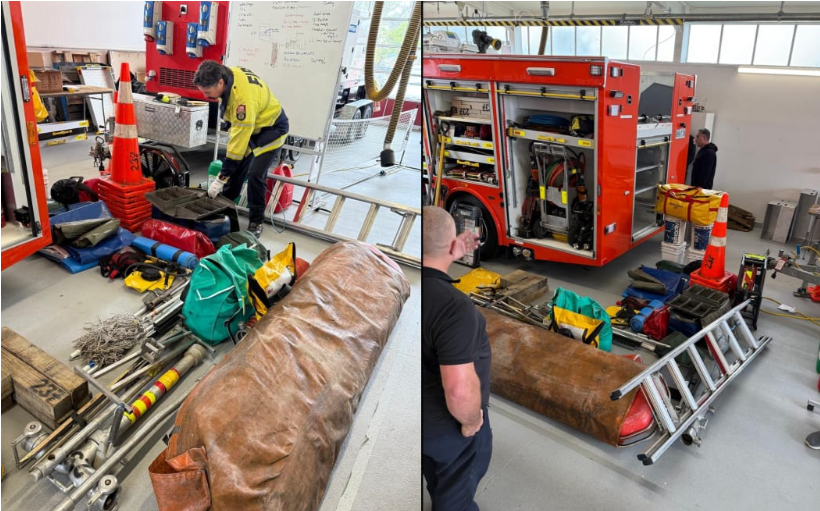Top Stories
New Fire Trucks Fail to Accommodate Essential Rescue Gear

Fire and Emergency New Zealand (FENZ) is facing significant operational challenges after discovering that its new fleet of fire trucks cannot accommodate essential rescue equipment. The 28 medium-sized fire trucks, designated as Type 3, have proven too small to house the lifesaving gear necessary for effective emergency responses. Firefighters have expressed frustration, noting that managers have even suggested cutting holes in the vehicles to create additional space for equipment.
During tests conducted last month, firefighters experienced difficulties fitting vital gear into the new trucks, prompting immediate concerns about their usability in real-life rescue situations. Jamie Marshall-Carter, a firefighter from Hamilton, highlighted the issue, stating, “We were trying to get to other important rescue gear and we were unable to get it out because we were having to offload things on top.” This trial was halted after just four hours due to the ineffective configuration of the gear.
The issue arose after FENZ invested millions of dollars and five years in outfitting these trucks in Britain. Upon their return to New Zealand, many fire stations, already reliant on aging vehicles prone to breakdowns, anticipated receiving the new trucks. However, the two trial runs at packing the gear resulted in significant challenges, including storing critical equipment on the floor and struggling to access necessary tools.
Operational Concerns and Management Responses
The situation has prompted concern among firefighters, particularly as vital equipment such as decontamination gear and rescue stretchers could not fit inside the vehicles. Adam Wright, a senior firefighter in Auckland, described the disarray during a test on September 9, 2023. “By the end of that morning, we had probably 20 percent of our firefighting and rescue gear sitting on the floor without a home for it,” he stated. This raises questions about the trucks’ effectiveness in emergency scenarios.
Megan Stiffler, the new deputy national commander of FENZ, acknowledged the situation as “not ideal” but emphasized that the organization is working towards a solution. She noted that the project team, which included firefighters, had agreed on standard equipment for the trucks. However, it appears that specific local needs were overlooked, resulting in a mismatch between the equipment list and the actual requirements of various fire stations.
Union representatives from the firefighters’ union have voiced their dissatisfaction with the current design of the trucks. Wright circulated an email following the Auckland test, stating that the current model is unsuitable for use as a rescue tender. Marshall-Carter’s team in Hamilton has already informed FENZ that they will not utilize the trucks in their current state.
Moving Forward: Finding Solutions
Stiffler emphasized the importance of collaboration, stating that FENZ is committed to understanding and addressing the specific needs of local fire crews. She acknowledged the oversight in the inventory list sent to the UK, which did not account for essential equipment that varies by location.
Despite the challenges, both Marshall-Carter and Wright are hopeful that a resolution will be reached. They are aware that while the trucks may serve adequately as water pumps, their inability to accommodate critical rescue gear poses a serious concern. The pair emphasized that all equipment is essential, not optional, and must be included for effective operation.
As negotiations between FENZ and the Professional Fire-fighters’ Union continue, the urgency of updating the fleet remains a pressing issue. Local union president Aaron McKay expressed disappointment regarding the delay in receiving new trucks, which would have replaced the aging and unreliable fleet currently in use.
Stiffler confirmed that the trucks are in the process of transitioning ownership from the manufacturers to FENZ, which includes further modifications to ensure they meet operational needs. While the organization is currently a week behind schedule, Stiffler reassured that solutions are being sought to rectify the situation.
The challenges posed by the new fire trucks underscore the necessity of ensuring that emergency services are equipped to respond effectively to critical situations, safeguarding both firefighters and the communities they serve. As FENZ works to resolve these issues, the commitment to improving operational readiness remains paramount.
-

 World4 months ago
World4 months agoTest Your Knowledge: Take the Herald’s Afternoon Quiz Today
-

 Sports4 months ago
Sports4 months agoPM Faces Backlash from Fans During Netball Trophy Ceremony
-

 Lifestyle4 months ago
Lifestyle4 months agoDunedin Designers Win Top Award at Hokonui Fashion Event
-

 Entertainment5 months ago
Entertainment5 months agoExperience the Excitement of ‘Chief of War’ in Oʻahu
-

 Sports4 months ago
Sports4 months agoLiam Lawson Launches New Era for Racing Bulls with Strong Start
-

 World5 months ago
World5 months agoCoalition Forms to Preserve Māori Wards in Hawke’s Bay
-

 Health4 months ago
Health4 months agoWalking Faster Offers Major Health Benefits for Older Adults
-

 Lifestyle4 months ago
Lifestyle4 months agoDisney Fan Reveals Dress Code Tips for Park Visitors
-

 Politics4 months ago
Politics4 months agoScots Rally with Humor and Music to Protest Trump’s Visit
-

 Top Stories5 months ago
Top Stories5 months agoUK and India Finalize Trade Deal to Boost Economic Ties
-

 Health2 months ago
Health2 months agoRadio Host Jay-Jay Feeney’s Partner Secures Visa to Stay in NZ
-

 World5 months ago
World5 months agoHuntly Begins Water Pipe Flushing to Resolve Brown Water Issue









